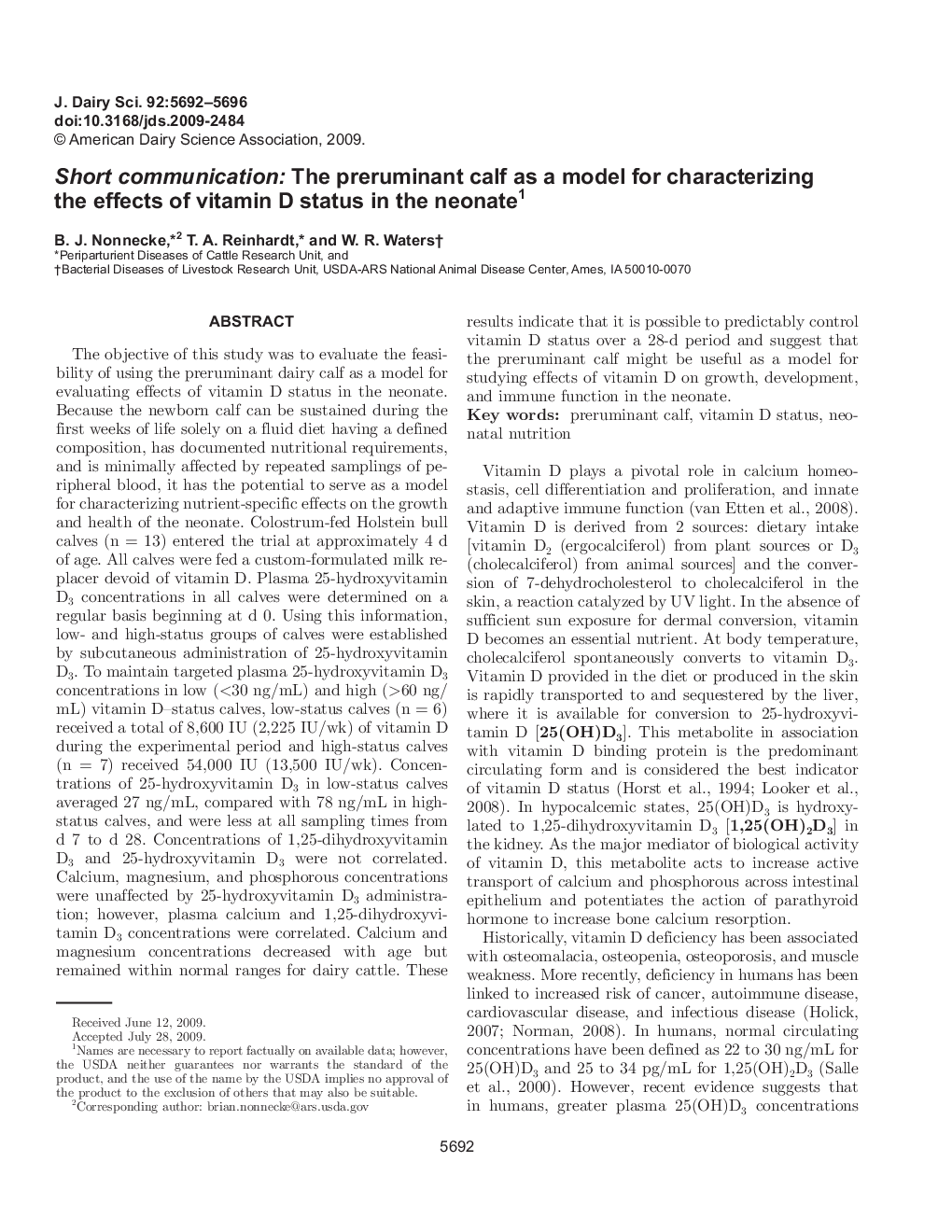| کد مقاله | کد نشریه | سال انتشار | مقاله انگلیسی | نسخه تمام متن |
|---|---|---|---|---|
| 2439131 | 1108087 | 2009 | 5 صفحه PDF | دانلود رایگان |
عنوان انگلیسی مقاله ISI
Short communication: The preruminant calf as a model for characterizing the effects of vitamin D status in the neonate1
دانلود مقاله + سفارش ترجمه
دانلود مقاله ISI انگلیسی
رایگان برای ایرانیان
کلمات کلیدی
موضوعات مرتبط
علوم زیستی و بیوفناوری
علوم کشاورزی و بیولوژیک
علوم دامی و جانورشناسی
پیش نمایش صفحه اول مقاله

چکیده انگلیسی
The objective of this study was to evaluate the feasibility of using the preruminant dairy calf as a model for evaluating effects of vitamin D status in the neonate. Because the newborn calf can be sustained during the first weeks of life solely on a fluid diet having a defined composition, has documented nutritional requirements, and is minimally affected by repeated samplings of peripheral blood, it has the potential to serve as a model for characterizing nutrient-specific effects on the growth and health of the neonate. Colostrum-fed Holstein bull calves (n = 13) entered the trial at approximately 4 d of age. All calves were fed a custom-formulated milk replacer devoid of vitamin D. Plasma 25-hydroxyvitamin D3 concentrations in all calves were determined on a regular basis beginning at d 0. Using this information, low- and high-status groups of calves were established by subcutaneous administration of 25-hydroxyvitamin D3. To maintain targeted plasma 25-hydroxyvitamin D3 concentrations in low (<30 ng/mL) and high (>60 ng/mL) vitamin D-status calves, low-status calves (n = 6) received a total of 8,600 IU (2,225 IU/wk) of vitamin D during the experimental period and high-status calves (n = 7) received 54,000 IU (13,500 IU/wk). Concentrations of 25-hydroxyvitamin D3 in low-status calves averaged 27 ng/mL, compared with 78 ng/mL in high-status calves, and were less at all sampling times from d 7 to d 28. Concentrations of 1,25-dihydroxyvitamin D3 and 25-hydroxyvitamin D3 were not correlated. Calcium, magnesium, and phosphorous concentrations were unaffected by 25-hydroxyvitamin D3 administration; however, plasma calcium and 1,25-dihydroxyvitamin D3 concentrations were correlated. Calcium and magnesium concentrations decreased with age but remained within normal ranges for dairy cattle. These results indicate that it is possible to predictably control vitamin D status over a 28-d period and suggest that the preruminant calf might be useful as a model for studying effects of vitamin D on growth, development, and immune function in the neonate.
ناشر
Database: Elsevier - ScienceDirect (ساینس دایرکت)
Journal: Journal of Dairy Science - Volume 92, Issue 11, November 2009, Pages 5692-5696
Journal: Journal of Dairy Science - Volume 92, Issue 11, November 2009, Pages 5692-5696
نویسندگان
B.J. Nonnecke, T.A. Reinhardt, W.R. Waters,